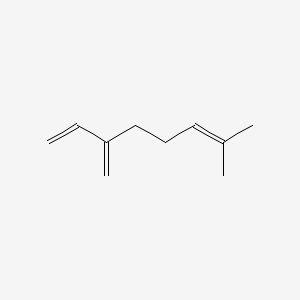| Authors | Title | Published | Journal | PubMed Link |
|---|---|---|---|---|
| pmid: | ||||
| Iurescia S et al. | Identification and sequencing of beta-myrcene catabolism genes from Pseudomonas sp. strain M1. | 1999 | Appl. Environ. Microbiol. | pmid:10388678 |
| Miyazawa M and Murata T | Biotransformation of beta-myrcene by the larvae of common cutworm (Spodoptera litura). | 2000 | J. Agric. Food Chem. | pmid:10691603 |
| Bohlmann J et al. | Terpenoid secondary metabolism in Arabidopsis thaliana: cDNA cloning, characterization, and functional expression of a myrcene/(E)-beta-ocimene synthase. | 2000 | Arch. Biochem. Biophys. | pmid:10700382 |
| Jouenne E and Crouzet J | Effect of pH on retention of aroma compounds by beta-lactoglobulin. | 2000 | J. Agric. Food Chem. | pmid:10775385 |
| Ajisaka N et al. | Effects of branched cyclodextrins on the solubility and stability of terpenes. | 2000 | Biosci. Biotechnol. Biochem. | pmid:10830484 |
| Choi HS and Sawamura M | Composition of the essential oil of Citrus tamurana Hort. ex Tanaka (Hyuganatsu). | 2000 | J. Agric. Food Chem. | pmid:11052747 |
| Bertolini AC et al. | Stability of monoterpenes encapsulated in gum Arabic by spray-drying. | 2001 | J. Agric. Food Chem. | pmid:11262028 |
| Choi HS and Sawamura M | Volatile flavor components of ripe and overripe ki-mikans (Citrus flaviculpus Hort. ex Tanaka) in comparison with Hyuganatsu (Citrus tamurana Hort. ex Tanaka). | 2001 | Biosci. Biotechnol. Biochem. | pmid:11272845 |
| Bylaite E et al. | Dynamic deadspace-gas chromatography-olfactometry analysis of different anatomical parts of lovage (Levisticum officinale Koch.) at eight growing stages. | 2000 | J. Agric. Food Chem. | pmid:11312790 |
Myrcene
Myrcene is a lipid of Prenol Lipids (PR) class. Myrcene is associated with abnormalities such as Hypomenorrhea, abnormal fragmented structure, Nephrosis, Renal tubular disorder and Kidney Diseases. The involved functions are known as Anabolism, Gene Expression, Protein Biosynthesis, Mutation and Selection, Genetic. Myrcene often locates in Plastids, Proboscis, Body tissue, Clone and soluble. The associated genes with Myrcene are TTPA gene, monoterpene synthase, Genome, 4S-limonene synthase and Homologous Gene. The related lipids are Pinene, Octanols, Membrane Lipids and Fatty Acids, Unsaturated.
Cross Reference
Introduction
To understand associated biological information of Myrcene, we collected biological information of abnormalities, associated pathways, cellular/molecular locations, biological functions, related genes/proteins, lipids and common seen animal/experimental models with organized paragraphs from literatures.
What diseases are associated with Myrcene?
Myrcene is suspected in Nephrosis, Kidney Diseases, Dehydration, Hypomenorrhea, Renal tubular disorder and other diseases in descending order of the highest number of associated sentences.
Related references are mostly published in these journals:
| Disease | Cross reference | Weighted score | Related literature |
|---|
No disease MeSH terms mapped to the current reference collection.
PubChem Associated disorders and diseases
What pathways are associated with Myrcene
There are no associated biomedical information in the current reference collection.
PubChem Biomolecular Interactions and Pathways
Link to PubChem Biomolecular Interactions and PathwaysWhat cellular locations are associated with Myrcene?
Visualization in cellular structure
Associated locations are in red color. Not associated locations are in black.
Related references are published most in these journals:
| Location | Cross reference | Weighted score | Related literatures |
|---|
What functions are associated with Myrcene?
Related references are published most in these journals:
| Function | Cross reference | Weighted score | Related literatures |
|---|
What lipids are associated with Myrcene?
Related references are published most in these journals:
| Lipid concept | Cross reference | Weighted score | Related literatures |
|---|
What genes are associated with Myrcene?
Related references are published most in these journals:
| Gene | Cross reference | Weighted score | Related literatures |
|---|
What common seen animal models are associated with Myrcene?
There are no associated biomedical information in the current reference collection.
